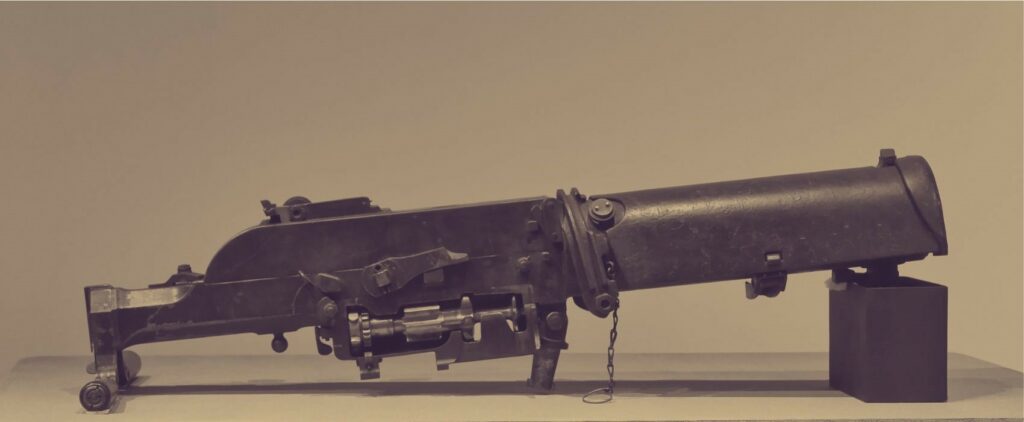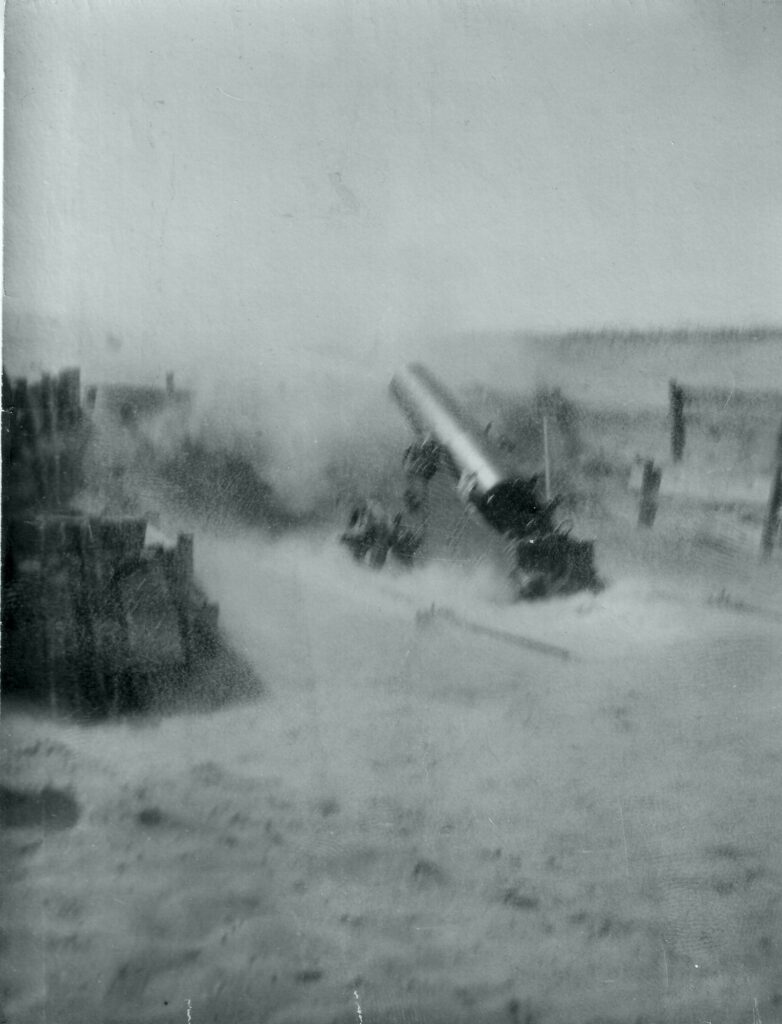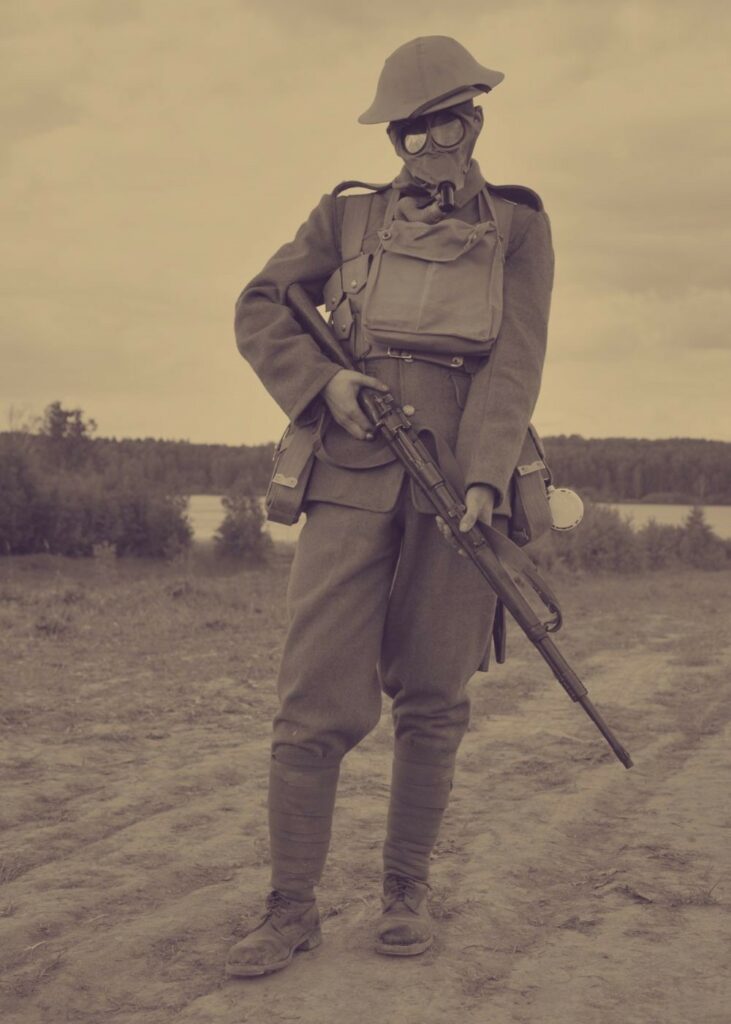How Did World War I Change Weapons for Today?
Published: 10 March 2023
Special to the Doughboy Foundation web site

US-soldiers-of-the-American-Expeditionary-Force
World War I marked a major turning point in military history, as the weapons and tactics used during that conflict have had lasting effects on modern warfare.
The use of technology and new forms of weaponry changed the face of battle forever, with devastating results for those involved.
From machine guns to chemical weapons, WWI saw some of the first uses of many now-standard pieces of equipment.
New Developments in Technology and Tactics
WWI saw a great advancement in technology and tactics that ultimately changed the way wars are fought.
New weapons such as machine guns, chemical weapons and aircraft helped to revolutionize the battlefield.
New tactics which were developed, such as trench warfare, strategic bombing and camouflage, helped further shape how future conflicts would be waged.
Mechanized Vehicles, Tanks, And Aircraft
WWI was the first major conflict to feature the use of mechanized vehicles like tanks, armored cars and even rudimentary airplanes in combat.
This marked a revolutionary shift in warfare tactics, as these machines allowed armies to traverse terrain with greater speed and mobility than ever before.
Armored Cars
Armored cars were introduced in WWI as a means of defense against machine guns and other weapons of war.
These vehicles had thick, armored plating made from steel or other materials that could protect the crew inside from shrapnel and bullets.
After the war, these vehicles became increasingly popular with militaries around the world and they continue to be used today by armed forces for reconnaissance and other missions.
The design of modern armored cars has evolved over the years to include improved ammunition protection, faster speeds, better off-road capabilities, and advanced electronics and sensors.
Armored cars are now being used in a variety of roles such as border protection, counter-terrorism operations, and security detail work.
They are also being used in law enforcement and other civilian organizations to protect personnel, resources, and property.
Tanks
Tanks were used both offensively and defensively during WW1, providing protection from enemy fire and the ability to quickly break through enemy lines.

British Mark I Tank
The first tank was the British Mark I, which entered service into combat on September 15, 1916. It had a top speed of 4 mph and could carry up to eight men plus their equipment.
The French soon followed suit with the Schneider CA1 which entered service in 1916. This tank was armed with machine guns or light cannons, and could travel at speeds of up to 7 mph.
Aircraft
Aircraft also had a significant impact on WW1, as they provided air support for ground troops and allowed for reconnaissance of enemy positions.
The first warplanes were primitive, consisting mainly of fabric-covered frames with small engines and rudimentary armaments.
However, they revolutionized warfare, allowing for reconnaissance missions to be conducted over enemy lines and opening up the possibility of aerial combat.
This led to an arms race in aircraft technology, as countries raced to develop more advanced planes with powerful engines and effective weaponry.
This development set the stage for aerial warfare in future wars, including World War II, which saw major advances in fighter planes and bombers.
Most of today’s aircrafts are derived from the designs created during WWI, such as propeller-driven fighters and bombers, as well as newer designs like jets.
The concept of dive bombing was developed during WWI, in which planes were flown at a steep angle in order to drop bombs on particular targets more accurately.
This tactic has been used numerous times since WWI, including in more recent conflicts such as the Vietnam War.
The development of these new weapons during WWI led to their increased use in future conflicts, including WWII and subsequent wars.
The technology of tanks and aircraft has also been continually upgraded since WW1, leading to the modern day battle tanks and fighter jets used by many nations for defense.
In addition, the use of mechanized vehicles in combat led to increased development of anti-tank weapons and air defense systems over the years. As a result, these technologies are now a mainstay of modern warfare and continue to shape the way we fight wars today.
New Weapons and Ammo
WWI brought about new and devastating weapons of war that drastically changed the way battles were fought. The introduction of automatic machine guns, high-explosive shells, chemical weapons, grenades and mortars made an incredible impact on warfare.
Ammunition
World War 1 brought about drastic changes in the way weapons and ammunition were used. In particular, the introduction of high explosive shells forever changed warfare.
High-explosive shells contained a larger amount of explosives than traditional bullets, allowing them to cause devastating damage from much farther distances compared to guns firing regular bullets, which made a couple of them more efficient than the whole bulk of traditional ones.
The use of high-explosive shells also meant that it was much easier for soldiers to take out multiple targets at once.
Other ammunition innovations introduced during WW1 included the use of incendiary rounds and smoke rounds.
Incendiary rounds were essentially bullets filled with flammable materials designed to ignite upon impact, creating an intense fire capable of destroying entire buildings and bunkers in a matter of minutes.
Smoke rounds, on the other hand, were designed to obscure vision and help soldiers conceal their movements in battle.
The use of these two types of ammunition was also an important factor in significantly reducing casualties during WW1.
By creating a smokescreen that clouded out enemy vision, soldiers could make moves without being seen by the enemy and limit their risk of being hit.
Similarly, incendiary rounds allowed soldiers to quickly and effectively target enemy bunkers and other fortifications, allowing them to move in closer for more efficient attacks with fewer losses on their side.
9mm ammunition was a key component of weaponry during World War I. The 9x19mm Parabellum round, commonly known as the 9mm Luger, was first developed by German arms manufacturer Georg Luger in 1902.
It quickly became one of the most popular rounds for handguns and submachine guns due to its stopping power and accuracy at short range engagements.
During WWI, this round saw widespread use among all sides in the conflict, with both Allied and Central Powers forces relying on it for close-quarters combat situations.
Its popularity has continued throughout the 20th century and into today’s modern battlefields where it remains a staple choice of bulk ammunition for many military personnel.
Handguns
For centuries, battles had been fought using swords and spears, but with the invention of firearms and other small arms, combatants could now engage each other at longer distances than before.
Handguns such as the iconic Colt 1911 pistol were used to great effect by both Allied and Axis forces, and soon formed an integral part of the standard infantry arsenal.
Today, many of the handguns used during WWI still remain popular among military and law enforcement personnel around the world.
The impact of these weapons on modern warfare is undeniable, as they have given combatants a powerful edge in close-quarters combat.
Machine Guns
One of the most significant military advances during World War I was the introduction of large-scale machine gun technology.
The invention of the quick-firing, belt-fed water cooled machine gun allowed combatants to lay down deadly, sustained barrages and cover huge swaths of land with a single weapon.
This had an immense impact on modern warfare, as it allowed infantry to engage in trench warfare with relative safety.

The German MG 08/15 was one such model that was used extensively by the German army during WWI. It was an adaptation of the earlier Maxim gun, with a decreased weight and improved rate of fire.
Other machine guns that were introduced during WWI included the French Chauchat machine gun, the British Lewis Gun, and the American Browning Automatic Rifle (BAR).
These weapons revolutionized warfare in the 20th century, and remain in use today. They have also served as the inspiration for a variety of modern machine gun designs.
Machine guns provided a defensive edge to entrenched troops and became incredibly effective weapons at close quarters.
These new technological advances allowed for an unprecedented level of destruction and death, as well as introducing a new form of warfare known as trench warfare.
This type of warfare, which was marked by long periods spent hiding in trenches due to the deadly machine gun fire, caused millions of casualties during WWI and would become standard practice in modern wars.
Grenades and Mortars
In WWI, grenades quickly became an essential tool for both sides in their respective offensives and defensive strategies.
Grenades allowed soldiers to break through enemy defenses by creating an explosion that could clear any obstacles blocking the way. They also allowed soldiers to launch an offensive attack quickly and effectively.

They were a major factor in trench warfare in WWI. Trenches had become a major form of defense as they provided troops with protection from enemy fire.
However, grenades could be used to easily breach these trenches and allow soldiers to quickly gain ground.
Grenades were also incredibly useful for clearing out bunkers and other defensive structures that had previously been difficult to attack without sustaining heavy casualties.
Mortars are one of the most widely used weapons to this day, used by militaries and armed forces around the world.
The mortar first appeared during WWI, initially developed in France and then copied by Germany in 1915.
Mortars were particularly effective in trench warfare, proving a reliable and lightweight weapon that could launch explosives into enemy trenches.
The British Army used the mortars extensively during the Battle of the Somme in 1916, and they proved so effective that their use continued long after the end of WWI.
Today, mortars are still commonly used in urban warfare and as a support weapon on the battlefield.
Chemical Weapons
Chemical weapons were also used for the first time in WWI. This included gasses such as chlorine and mustard gas, which were released from canisters or shells and would spread over a large area, resulting in many casualties.

This deadly new weapon of mass destruction caused fear among troops, but also led to the development of protective equipment such as gas masks, which are still used today.
Tactics
WWI saw the development of new tactics such as trench warfare, strategic bombing and camouflage.
Trench warfare helped to protect troops from enemy fire while they were in a defensive position, while strategic bombing allowed Allied forces to target key enemy locations from the air.
Camouflage was also used as it helped soldiers remain undetected in the battlefield.
All of these tactics are still utilized today and have become essential to many modern conflicts.
Overall, WWI saw a major advancement in technology and tactics that shaped how wars are fought for generations to come.
From machine guns and chemical weapons to aircraft, trench warfare, strategic bombing and camouflage, this conflict changed the nature of warfare forever.
This legacy lives on today and will continue to influence the way wars are fought in the future.
WWI’s Effect on the USA
The impact of World War I on the United States was truly transformative. For the first time, Americans were called to serve their country in a large-scale conflict overseas and thousands answered the call.
The U.S. military was thrust into modern warfare, where technological advances quickly became evident. As a result, the American army developed more sophisticated weapons and tactics.
Perhaps most importantly, WWI necessitated the development of lethal chemical weapons and the use of aerial warfare for strategic purposes.
Technological advances forced armies to adopt more sophisticated strategies, and the United States quickly adopted a variety of new weapons.
For example, the M1917 Enfield rifle replaced the M1903 Springfield as the primary weapon for U.S. infantrymen.
This was due in part to its capability to fire five rounds per minute compared to three with the Springfield.
Likewise, American forces adopted machine guns like the Maxim gun, which proved to be deadly in large-scale combat.
The United States developed and employed chlorine gas, sulfur mustard gas and phosgene as lethal weapons. Of course, poison gas had devastating effects on soldiers and civilians alike.
Unfortunately, the effects of these weapons are still being felt in the present day, with many WWI veterans suffering from long-term health complications due to their exposure.
Aerial combat was another major change for U.S. forces during WWI.
In the early days of aviation, planes were used mostly for observation and reconnaissance purposes. However, as the technology developed, aircraft became far more sophisticated and were used to launch attacks on enemy forces.
This meant that American pilots had to be trained in air-to-air combat and the development of aerial tactics such as formation flying, dive bombing, and dogfighting.
WWI marked a major turning point for modern warfare and changed weapons forever. The introduction of tanks, machine guns, poison gas, and aerial combat all had a profound effect on how battles were fought.
WW1 had a lasting impact on the way that the United States and its military view weapons and warfare today. After WW1, the US Armed Forces began to shift towards more modern methods of combat, such as airpower, mechanization, and improved communications.
This resulted in the development of new weapons systems such as bombers, tanks, aircraft carriers, and long-range missiles.
The use of artillery and chemical weapons during WWI led to more effective targeting strategies on both sides of the conflict.
It also resulted in a new appreciation for defensive tactics such as fortifications, trenches, bunkers, and other prepared positions along with more mobile and aggressive tactics such as blitzkrieg.
The use of aircraft in WW1 also paved the way for modern-day airpower, which can cover vast distances quickly, strike with precision and accuracy, and provide battlefield intelligence.
The development of fighter aircraft during WWI led to the creation of new technologies such as radar systems, electronic warfare, and the use of weapons in space.
WWI also had a deep impact on the way that the United States views conflict resolution and diplomacy today.
The harsh peace treaties imposed after WWI, such as the Treaty of Versailles, ushered in a new era of international relations where diplomatic solutions to disputes are preferred over military ones.
This has opened the door for more peaceful resolutions to international disputes as well as stronger alliances between countries.
Final Thoughts
World War I was a turning point for weapon technology and the way wars were fought. It brought about rapid developments in machine guns, artillery, tanks, submarines, aircraft carriers and chemical weapons.
These advances had an immense impact on warfare which still affects us today – from the shape of modern battlefields to the use of drones and more powerful explosives.
The legacy of WWI has been felt throughout history; it is one that will continue to resonate as we look towards new technologies and strategies for future conflicts.
Whether it be through increased precision or improved protection against deadly gasses, World War I changed weaponry forever – both positively and negatively – setting up our current day military capabilities for success or failure depending upon how they are used.
External Web Site Notice: This page contains information directly presented from an external source. The terms and conditions of this page may not be the same as those of this website. Click here to read the full disclaimer notice for external web sites. Thank you.



